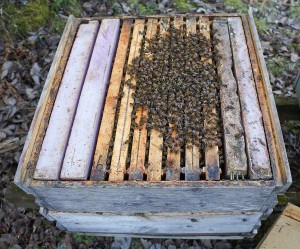Colony 47 is a remarkable colony. It started as a walkaway split last year. From colony 236. It is placed in apiary 4 as colony no 7. The split was moved from apiary 23 to apiary 4. When I checked the walkaway splits a week later I saw that 47 was a strong split so I stole some brood combs and bees to form additional splits together with other ”stolen brood combs and food combs with bees from other strong walkaway splits. Those new formed splits with ”stolen” brood and combs were moved to still another apiary and got a mature queen cell.
The initial walkaway splits raised their own queens. Colony 47 succeeded in producing a laying queen and grew. But close to ”bedding down” for winter, when feeding somewhat extra as honey didn’t seem to be enough for winter, I saw that the size of the cluster had shrinked somewhat, to my surprise so I shrank the space for winter inserting dummy/insulating combs in the two boxes that this colony were going to winter in.
Did they have varroa and virus problems as they shrank in size? A queen of the same year seldom quit laying early in the fall as older queens of my stock normally do (when not affected by mites and viruses). If mites and viruses are a problem often dead bees are lying outside the entrance, if wingless bees are seen that’s a definitive sign. But nothing like that. It was clean. They took the feed very well. The colony was heavy enough considering the size, so it kept the feed, no robbing from others.
I kept an eye on the colony as I was interested how it would make it through the winter. The cluster diminished in size following the temperature and sat still as a healthy colony should behave. That’s good. I looked mainly through the plastic cover sheet when I visited the apiary, but sometimes opened up, yes in winter, it’s okey if you are quick.
The temperature went down to below 10 degrees below freezing (-10C/15F), it didn’t go colder this winter, for a couple of weeks in late January, though I’m at 59°N latitude (and 15° E longitude). The Golf stream is making the difference. Then I didn’t see the bees, well when I took off the plastic, and looked with a flash light I could see a small cluster down below in the two shallow boxes. It looked like two fists in size, but probably somewhat bigger, like 5 tennisballs or so. Very tight cluster, still. Yesterday after a cold night, some degrees below freezing, it looked like on the picture. In daytime yesterday temperature raised to just below 15C (60F). Grass have just started to grow, actually we cut one part of the lawn yesterday. Spring flowers like scilla are giving some nectar and pollen, of course the very important willow. But trees are still bare.
Colony 47 didn’t get any treatment for varroa last year. The mother colony 236 didn’t either. Actually 236 was the only colony in her apiary that didn’t get any treatment (thymol). It gave well above average in honeyyield. It has wintered very nicely on three shallow boxes full of frames and bees.
It will be very interesting to test these two colonies for VSH later this season!
Actually I have a colony that behaved and wintered in a very similiar way last winter, which was a very hard one. That was colony 137. That colony was the only one in its apiary last season I didn’t treat, neither in 2012. It has wintered successfully as well this winter. That colony was the third I tested for VSH last year. I didn’t manage to get a value for VSH as I didn’t find one single mite in the brood. Of course that’s why I didn’t have to treat. That would have been unfair to them.
Today I will start to check my colonies for the need of increase and additional food frames which I have stored over the winter.

